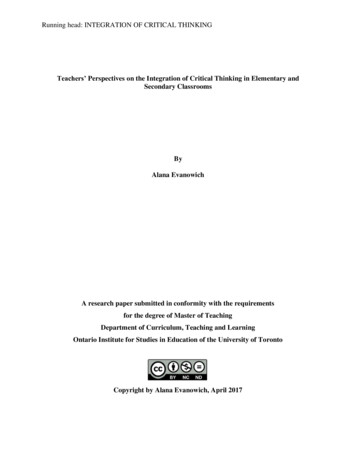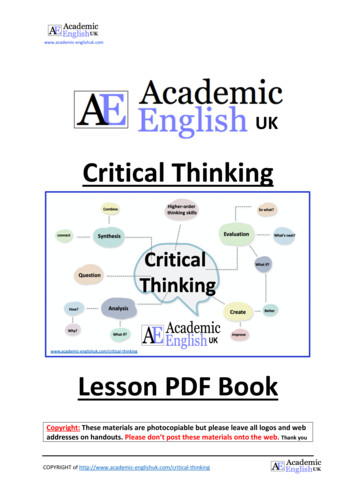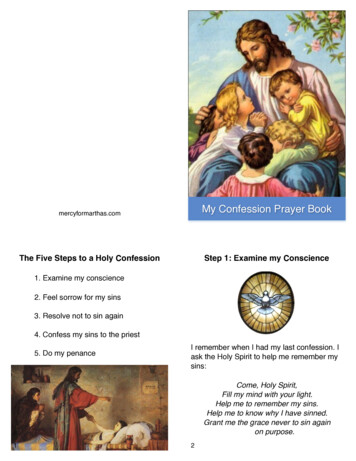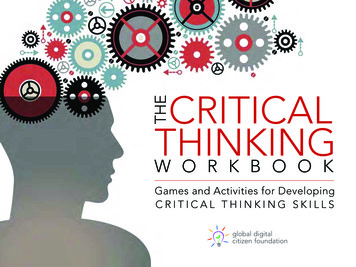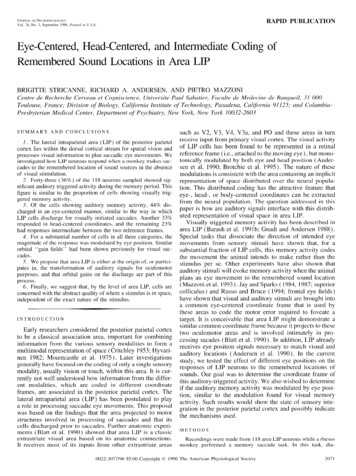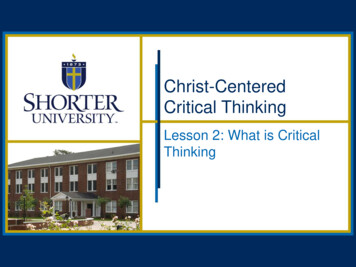
Transcription
Christ-CenteredCritical ThinkingLesson 2: What is CriticalThinking1
Lesson ObjectivesIn this lesson we will:1. Define critical thinking2. Learn four prominent features of critical thinking3. Learn three parts of critical thinking4. Review a critical thinking model5. Apply SEE-I method for understanding andclarifying a key concept or idea2
3Let’s look at threedefinitions ofcritical thinking.What concepts orthemes arecommon to eachdefinition?RobertEnnis Critical thinking is reasonable,reflective thinking that isfocused on deciding what tobelieve or do.RichardPaul Critical thinking is thinkingabout your thinking, while youare thinking, in order to makeyour thinking better.ShorterUniversity Christ-Centered criticalthinking analyzes, synthesizes,and evaluates the tensionbetween truth and experienceas we pursue wisdom througha biblical worldview.
4NegativeNow that we knowwhat critical thinkingis, let’s look at whatit is not. Critical thinkers look atboth sides of an issue.Emotionless Critical thinking is not amechanical processseparated from emotions.Undirected Critical thinking ispurposeful thinking.Critical thinking isNOT . . .
5PROMINENTFEATURESProminent featuresof critical thinkingare:REFLECTIVE Critical thinking begins withreflection.Our views are our conclusionsWhat evidence is my view based on?INVOLVESELEMENTS &STANDARDS Elements of thought Standards/criteria insure accuracy andcriteria aid in focusing on the question athand.AUTHENTIC Deals with real problems that are oftenmessy – unclear, and/or have no singleanswer. Critical thinking is more about what webelieve and do.BEINGREASONABLE There are no rules or step-by-stepprocedures that guarantee successfulreasoning. Simply following the stepsdoes not insure success. Critical thinking is self-correcting.
Three Parts of Critical ThinkingCritical thinking involves . . .1. Asking Questions2. Reasoning It Out3. Accepting the ResultsIn the next three slides, we will explore the partsof critical thinking.6
7AskingQuestionsThree Kinds of Questions1. Simple “yes/no” or“right/wrong”2. Opinion/preference3. Complex/Analytical –involves criticalthinking
8ReasoningThings OutReasoning things outtakes time and effort.Reasoning things outinvolves identifying theelements of thoughtand applying thestandards to theelements.Our investment of timeand effort will help indeveloping theintellectual traits.
9Accept theResults of OurThinkingAcceptanceHindrancesThe balance – middleground – betweenintellectual inferiorityand intellectualarrogance isintellectual humility.AcceptanceHindrancesInferiority Complex:“I can’t learn this, so why bother trying?”“I don’t know how to do the work, so I’ll justtry to get by without doing it.” – inferioritycomplex.Arrogance Complex:“I already know everything I need to knowabout this (subject, problem, situation).”“I don’t need to do the work to learn this stuff”– intellectual arrogance.
10Critical Thinking ModelThe IntellectualStandards are appliedto the Elements ofReasoning to developIntellectual Traits
11Resources forFurther StudyBassham, Gregory, William Irwin, Henry Nardone, andJames M. Wallace. Critical Thinking: A Student’sIntroduction, 2d ed. McGraw Hill, 2005.Mauk, John, Jayme Stayer, and Karen Mauk. Think AboutIt: Critical Skills for Academic Writing.Wadsworth Cengage Learning, 2014.
Questions?Email and comments to your instructor12
1. Define critical thinking 2. Learn four prominent features of critical thinking 3. Learn three parts of critical thinking 4. Review a critical thinking model 5. Apply SEE-I method for understand



